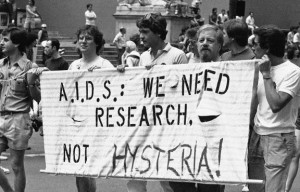Visiting an Exhibit on Early AIDS at the New York Historical Society
School’s back in session. With fall approaching, your author has resumed teaching and attending lectures. Today I had the chance to visit the New-York Historical Society where an exhibit, AIDS in New York: The First Five Years is winding down. The display closes in two days.

The opening scene, by the first room’s entrance, is breathtaking in a way. There’s a huge picture of men, countless, basking in the sun on a Hudson pier. The men looked relaxed, comfortable and healthy – blissfully unaware of what lies ahead. The exhibit takes you through the late 70’s club scene, with just a few pictures of that, and then moves to confusing and odd reports of unusual infections in homosexual men, intravenous drug addicts, hemophiliacs and Haitians. The show moves on into the early 80’s, when science steps in slowly, and most politicians keep away.
What’s clear is that most doctors didn’t know what was going on. The young men weren’t sure either. There were rumors but also credible denials about a disease affecting the community. Gradually, the city’s Department of Health and CDC started tracking the problem. There were protests, and activists, and friends helping friends to die. There was no therapy back then, except to temper some of the infections and treat the once-rare cancers we were seeing with strange frequency.
I had the fortune of walking through the exhibit today among a group of suburban high school students – kids who were born after the invention of anti-retroviral therapy. Their questions – some simple and others intense, and the relatively young guide’s recounting of her experiences during the early AIDS years, made me realize how crucial is this history. It was a terrifying health problem, then.
Yes, the historical society’s exhibit is neat and tidy. I remember, well, caring for young people who died, hopelessly. The gravity of the epidemic isn’t captured. But it’s a worthwhile review, nonetheless – especially for its bits on low-end media, like typed bulletins from the early Gay Men’s Health Crisis and early posters on safe sex. Those frank messages provided the only information some people at risk received about the emerging disease. The display includes a few passages and images having to do with patients helping patients. That was the best part.
Leave a Reply